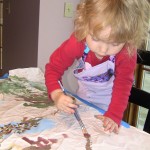May 28, 2013 • Curriculum
 I love Memorial Day. It is one of my favorite holidays, and not simply because it marks the unofficial start of summer. I love spring, I love the fresh, clean air of the outdoors. I love a holiday bike ride.
I love Memorial Day. It is one of my favorite holidays, and not simply because it marks the unofficial start of summer. I love spring, I love the fresh, clean air of the outdoors. I love a holiday bike ride.
I love the acknowledged break from work.
It’s true that I spent most of Monday working. But as an entrepreneur I spend most of every day working… and I love doing that. Even if I’m not sitting at my computer or diligently working on a visible project, my mind is always working. I’m writing my next blog post, composing my next witty tweet, or nurturing my next idea about how to effectively translate an unpalatable financial topic to an artistic audience.
And then I had a quick bike ride and a lovely evening barbecue. It was the best of all worlds.
But as I enjoyed an ideal day I enjoyed as well the spirit behind the day. If nothing else, the day is meant to celebrate all we have and recall the sacrifices of those who provided it for us. My grandfathers were both veterans of World War II, and a collection of cousins served in various branches of the military. But unlike the wars of old, military service and the related sacrifices are increasingly borne by a shrinking number of families whose burdens far outweigh those of the rest of us.
Sure, we ride or run for Wounded Warriors, contribute to care packages, and soberly read articles about very personal attentions paid to our soldiers, like the one that graced the cover of Sunday’s Times. But those efforts feel so hollow, not the hallowed efforts of previous generations whose women happily filled jobs vacated by soldiers and sacrificed goods and consumption for the greater good.
But perhaps our duty is to help in a way that is personally meaningful, regardless of how it compares to others’ sacrifices. That’s what Melissa Walker does as an Art Therapist whose work focuses on creative, therapeutic outlets for military members and their families. She shared a bit of her experiences in a recent blog post for Americans for the Arts, “Understanding the Value of Art Therapy,” and I knew immediately I agreed with her, even before reading the article. (But do read the whole thing… It’s lovely.)
I am not an art therapist or a therapist of any kind. At all. Even remotely. But in the finance and accounting classes I teach to artists and creative individuals more broadly, I’ve witnessed the power of creativity in expressing new or challenging ideas, including those that cause us discomfort. I’ve watched students who otherwise deign to participate musing over a complicated idea while they manipulate play dough… and then offering thoughtful and insightful comments. I’ve seen students taking notes in a form that feels foreign to me, without numbers or words, but rather images, and for them, the ideas I’ve shared come to life in a meaningful and personal way. I see otherwise tired or skeptical eyes brighten when students enter a classroom whose desks are sprinkled with colorful pipe cleaners.
There’s something about color and texture that creates a welcoming, comfortable environment. It opens our minds and allows us to engage more creatively with whatever topic we’re pondering (and in my play dough-, pipe cleaner-filled classroom, it is usually a very technical topic). The color and texture doesn’t detract from the technical or challenging nature of the material any more than a colorful kindergarten classroom neglects to teach skills challenging to five-year-olds, like discipline, fine motor skills, or analytical reasoning.
And as Melissa Walker demonstrates, it helps with more challenging issues as well, issues and topics that are not only technical, but also fraught with emotional complications.
The arts are powerful. Our country is powerful. Our people, our ideas, and our disagreements are powerful. And what a testament to the strength and resilience of those who fought before us that not only does life continue, but it continues well, with a bit of creativity and passion preserved and fostered in us all.
And that, I suspect, was meaningful to my grandfathers and their peers, and protecting it is certainly meaningful to me.


